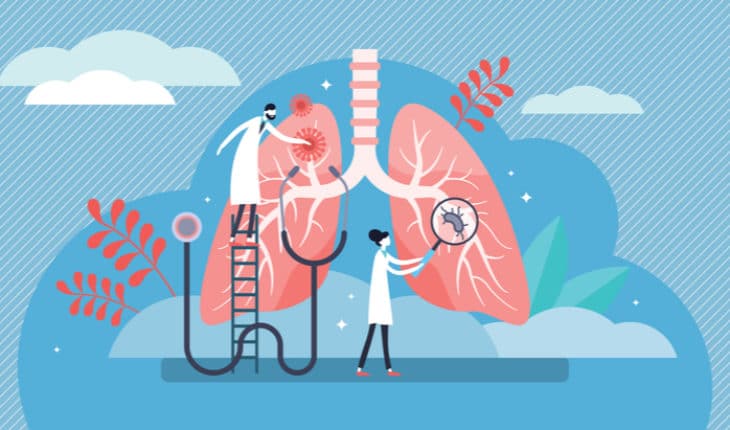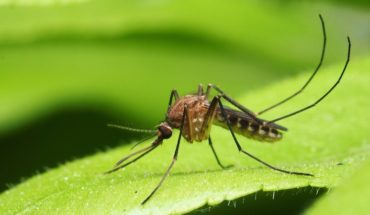Future of lung disease care ‘at risk’ due to workforce shortages and backlog from COVID-19: Staffing shortages are impacting diagnosis, treatment, and care of people with lung disease, according to the Taskforce for Lung Health
The Taskforce for Lung Health, a collaboration of over 30 charities, organisations and patients looking to improve lung health in England, has called for an urgent review into the current shortages in the respiratory workforce, and the potential long term impact of COVID-19 on staffing levels across the sector.
In 2018, when the Taskforce for Lung Health published its five year plan for improving lung health in England, staff shortages in pulmonary rehabilitation, nursing, primary care, secondary care, and radiology were among the areas identified as needing urgent reform to support the 1 in 5 people diagnosed with lung disease in their lifetime. Today, professional bodies sitting on the Taskforce have come together to raise attention to the lack of progress in increasing staff numbers, and the risks posed by the impact of the pandemic on respiratory care, a historically understaffed sector.
In fact, according to a recent survey by the British Thoracic Society, a member of the Taskforce, Respiratory Departments across the UK reported that well over two thirds (71%) of departments did not have enough medical staff to manage their workload.1
Professor Jon Bennett, Chair of the British Thoracic Society warns, “Without extra resources and staff, the respiratory workforce cannot adequately deliver routine and specialist clinics for the many people with lung problems while at the same time being expected to treat acute and post-COVID-19 patients, and run Long-COVID clinics.
“This means patients with lung disease are being deprived of access to the specialist expertise they need.
“The UK needs a larger and better funded respiratory workforce including consultants, nurses, physiotherapists, physiologists and all other essential, skilled professionals, to cope with the ever increasing demand for care.”
The Taskforce is warning that delays to rehabilitation for people with lung disease, compounded by the increasing numbers of people needing similar treatments for Long Covid, are increasing the pressures on a service which patients have historically struggled to access. Last year, many services offering pulmonary rehabilitation, a life-changing exercise and education treatment programme, were stopped completely or postponed, with at least a third of people with lung conditions reporting that they had their treatment cancelled, creating a backlog of people waiting for care.2 The Taskforce argues that this backlog (compounded by the rising number of Long Covid patients needing care), cannot be addressed without a commitment towards improving the numbers of trained, skilled respiratory professionals at all levels.
In December 2018, Taskforce member, the Chartered Society of Physiotherapy (CSP) estimated that an additional 1,000 staff members were needed to meet the growing demand for pulmonary rehabilitation.3 A little over two years later, according to the CSP, the COVID-19 patients who were in hospital in the first wave alone will require almost 2 million hours of rehab, and approximately 2,300 new physiotherapy posts will be required to address the community rehab needs of COVID recovery within one year.4
Rachel Newton, Head of Policy at the Chartered Society of Physiotherapy, said, “We are facing a serious and immediate shortage of physiotherapists and physiotherapy support workers in the UK. Although the registered workforce has been expanding for some time, it has simply not kept up with current demand and this is now even greater due to Covid19.
“Physiotherapy staff play a crucial role in treating these patients in intensive care and also prove rehabilitation for those suffering from Long Covid in the community. This is extra pressure on an already stretched workforce that provides life-saving and life-prolonging rehabilitation for patients with all kinds of lung conditions – conditions that for millions have got progressively worse due the pandemic.
“Whilst we need to see significant growth in the physiotherapy workforce, it is clear that the whole respiratory rehabilitation workforce needs to be expanded to meet current and projected needs. We believe that with the right clinical supervision and training, physio support workers and exercise professionals can help with this by playing greater roles in the short-term.”
Delays to lung disease diagnosis have also been compounded by shortages in the workforce. Radiologists play a vital role in diagnosing and managing lung disease by carrying out imaging and interpreting scans. But according to the Royal College of Radiologists, a member of the Taskforce, the workforce in 2019 was short a third of the staff needed to meet demand, with respiratory particularly affected as 1 in 5 trusts/health boards were missing a consultant.5 The latest census by the Royal College of Radiologists showed that workforce shortages have worsened in recent years, with a quarter of chest/lung radiologists due to retire within five years.6
It takes five years to train a chest radiologist, and the Taskforce is arguing that the lack of progress in increasing the numbers of radiologists has exposed the need for an immediate review into the shortages in staff equipped to help diagnose people with lung disease. A patient survey by Asthma UK and the British Lung Foundation found that 1 in 3 people waited more than six months for a diagnosis well before the pandemic, with 1 in 6 waiting longer than a year.7 This issue has only increased since the COVID-19 crisis as estimates suggest that the backlog of people waiting for a lung disease diagnosis is in the tens of thousands.8
Dr Graham Robinson, President of the British Society of Thoracic Imaging said, “Imaging, particularly CT scanning of the lungs, is vital for many respiratory diagnoses. It should also be more available direct from primary care. Pre-existing backlogs in CT scanning and reporting have been magnified during COVID19. The UK also has less CT scanners per head of population than the majority of our European neighbours. This, and the shortage of specialist thoracic radiologists, risks delays in diagnosis.
“NHS England are separately encouraging all the lung cancer screening pilots (lung health checks) to restart at full capacity, but as yet there remains no signed off national program, which will again only magnify staff and scanner shortages.”
Delays to diagnosis in primary care have also been heavily impacted by the pandemic.
Carol Stonham, Executive Chair at the Primary Care Respiratory Society, said, “In the lead up to the pandemic, primary care had been preparing to improve diagnostic spirometry with improved training and a move towards local diagnostic hubs at PCN level to deliver high quality diagnosis. For a year everything has been halted including available funding for spirometry training.
“We have a backlog of patients waiting for spirometry to confirm a provisional respiratory diagnosis and even more who are likely to present with new respiratory symptoms as well as symptoms resulting from deconditioning, anxiety and post Covid effects. We owe it to our patients to be able to offer a service that is fit for purpose.
“Our primary care workforce has, like all healthcare services, tackled the pandemic head on but are at the disadvantage of working in small teams without the back up and support of large organisations behind them. They are now taking on the extra workload of vaccinating millions at pace whilst trying to restore service as normal. Not surprisingly many of the workforce are exhausted.”
Alongside the impact to diagnosis and pulmonary rehabilitation, professional bodies representing the nursing sectors have also expressed concerns at the impact of the pandemic on respiratory staffing levels.
Wendy Preston, Head of Nursing Practice at the Royal College of Nursing & Consultant Respiratory Nurse, said, “Specialist nurses play a significant role in supporting patients with respiratory illnesses. If we want to build on the services we provide, we need to have enough nursing staff to provide safe and effective care for patients.”
“We know that approximately half of these specialist nurses could retire within the next six years, therefore it is critical that workforce is prioritised to attract to next generation of nurses and retain existing expertise.’
“The current pandemic has shown the importance of respiratory nursing expertise and we welcome the current work to build on this and develop Respiratory Support Units. It is essential that workforce features heavily in these plans as well as ensuring community and primary care services are developed collaboratively and are equitable.”
The Taskforce for Lung Health is now calling for an urgent review into the shortages in the respiratory workforce.
Alison Cook, Chair of the Taskforce for Lung Health, said, “The Taskforce for Lung Health has come together in a rallying cry to stress the fact that the future of respiratory treatment and care is at risk if nothing is done, now. For too long, we have seen a lack of progress in filling the vacant respiratory posts in our hospitals, GP practices and communities.
“It is no secret that outcomes for patients with lung conditions have not improved for over a decade, and that we urgently need to see a workforce equipped to support the millions of people in need. We must now see an immediate review into the current shortages in the respiratory workforce, and the potential long term impact of COVID-19 on staffing levels across the sector – the wellbeing of people living with lung disease depends on it”.
1 British Thoracic Society, 2020. https://www.brit-thoracic.org.uk/about-us/pressmedia/2020/bts-survey-finds-respiratory-departments-still-dangerously-under-resourced/
2. Asthma UK and British Lung Foundation survey, 2020. Data Collected 10th-19th October. https://www.blf.org.uk/taskforce/press-release/1-in-3-people-with-lung-disease-end-up-waiting-longer-than-six-months-for-a-diagnosis
3.Chartered Society of Physiotherapy, Physiotherapy Workforce Data Model, 2018.
4. Chartered Society of Physiotherapy, Physiotherapy After COVID Evaluation Interactive Data Dashboard 2021, available at: http://csppandd.eu.pythonanywhere.com/
5. Royal College of Radiologists, 2019, Clinical radiology UK Workforce census 2019 report, available at: https://www.rcr.ac.uk/system/files/publication/field_publication_files/clinical-radiology-uk-workforce-census-2019-report.pdf
6. Royal College of Radiologists, 2020, Clinical radiology UK workforce census 2020 report, available at: https://www.rcr.ac.uk/press-and-policy/policy-priorities/workforce/radiology-workforce-census
7. Asthma UK and British Lung Foundation survey, 2020. Data Collected 10th-19th October. https://www.blf.org.uk/taskforce/press-release/1-in-3-people-with-lung-disease-end-up-waiting-longer-than-six-months-for-a-diagnosis
8. An average of 3,399 patients per week missed out on urgent and routine referrals during the first lockdown, according to Taskforce analysis. https://www.blf.org.uk/taskforce/get-in-touch/media/patients-needing-urgent-care-for-lung-conditions
About the Taskforce for Lung Health
The Taskforce for Lung Health is a unique collaboration between patient representatives, health care professionals and other experts. Over 30 members have a shared vision for lung health; we want to transform the care and treatment for patients and change the mortality rate for lung disease, which has barely improved in over a decade.
Coming together for the first time in 2018, we developed a five-year plan to improve lung health in England. Our report makes vital, realistic recommendations to NHS England and other governing bodies about all aspects of lung health; from prevention and diagnosis right through to end of life care. Together, we’re giving people with lung disease a powerful voice. For further information visit www.blf.org.uk/taskforce
- Combination of drugs could prevent thousands of heart attacks - 21st April 2025
- UQ Study Links Poor Teen Diets to Heavy Social Media Use - 21st April 2025
- Gut microbiome could delay onset of type 1 diabetes - 3rd April 2025






